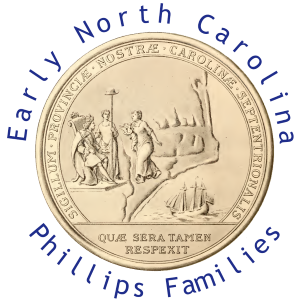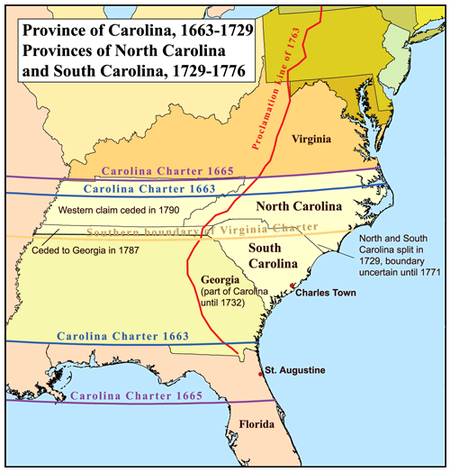Province of Carolina
From ENC Phillips Group Wiki
The Province of Carolina from 1663 to 1712, was a colony of British America, controlled by the Lords Proprietors, a group of eight English noblemen led informally by member Anthony Ashley-Cooper, 1st Earl of Shaftesbury. Dissent over governance of the province led to the appointment of a deputy governor to administer the northern half of the colony in 1691.
The division between North and South became complete in 1712, but both colonies remained in the hands of the same group of proprietors. A rebellion against the proprietors broke out in 1719 which led to the appointment of a royal governor for South Carolina in 1720. After nearly a decade in which the British government sought to locate and buy out the proprietors, both North and South Carolina became royal colonies in 1729.
Contents
Brief history
Following the restoration of the monarchy in 1660, Charles II of England rewarded eight persons on March 24, 1663, for their faithful support of his efforts to regain the throne of England. He granted the eight, called Lords Proprietors or simply Proprietors, the land called Carolina, named in honor of Charles I, his father.
1663 Charter
The 1663 charter granted the Lords Proprietor title to all of the land from the southern border of the Virginia Colony at 36 degrees north to 31 degrees north (along the coast of present-day Georgia). In 1665, the charter was revised slightly, with the northerly boundary extended to 36 degrees 30 minutes north to include the lands of settlers along the Albemarle Sound who had left the Virginia Colony. Likewise, the southern boundary was moved south to 29 degrees north, just south of present-day Daytona Beach, Florida, which had the effect of including the existing Spanish settlement at St. Augustine. The charter also granted all the land, between these northerly and southerly bounds, from the Atlantic, westward to the shores of the Pacific Ocean.
Lords Proprietors
| ||||
Of the eight, the one who demonstrated the most active interest in Carolina was Anthony Ashley Cooper. Lord Ashley, with the assistance of his secretary, the philosopher John Locke, drafted the Fundamental Constitutions of Carolina, a plan for government of the colony heavily influenced by the ideas of the English political scientist, James Harrington. Some of the other Lords Proprietors also had interests in other colonies: for instance, John Berkeley and George Carteret held stakes in the Province of New Jersey, and William Berkeley had an interest in Virginia.
The Lords Proprietors, operating under their royal charter, were able to exercise their authority with nearly the independence of the king himself. The actual government consisted of a governor, a powerful council, on which half of the councillors were appointed by the Lords Proprietors themselves, and a relatively-weak, popularly-elected assembly.
Although the Lost Colony on Roanoke Island represented the first English attempt at settlement in the Carolina territory, the first permanent English settlement was not established until 1653, when emigrants from the Virginia Colony, with others from New England and Bermuda, settled at the mouths of the Chowan and Roanoke Rivers, on the shores of Albemarle Sound, in the northeastern corner of present-day North Carolina. The Albemarle Settlements, pre-empting the royal charter by ten years, came to be known in Virginia as "Rogues' Harbor". [1]
In 1665, Sir John Yeamans established a second permanent settlement on the Cape Fear River, near present-day Wilmington, North Carolina, which he named Clarendon.
Another region was settled under the Lords Proprietors in 1670, to the south of the other settlements, near present-day Charleston, South Carolina. The Charles-Town settlement developed more rapidly than the Albemarle and Cape Fear settlements due to the advantages of a natural harbor and quickly-developing trade with the West Indies. Lord Shaftesbury specified the street plan for Charles-Town; the nearby Ashley and Cooper Rivers are named for him.
That southern settlement, which became known as Charleston, was the principal seat of government for the entire province. However, due to their remoteness from each other, the northern and southern sections of the colony operated more or less independently until 1691, when Philip Ludwell was appointed governor of the entire province. From that time until 1708, the northern and southern settlements remained under one government. The north continued to have its own assembly and council; the governor resided in Charleston and appointed a deputy-governor for the north. During this period, the two halves of the province began increasingly to be known as North Carolina and South Carolina.
Dissent
From 1708 to 1710, due to disquiet over attempts to establish the Anglican church in the province, the people were unable to agree on a slate of elected officials; consequently, there was no recognized and legal government for more than two years. This circumstance, coupled with the Tuscarora War and the Yamasee War, and the inability of the Lords Proprietors to act decisively, led to separate governments for North and South Carolina.
Some take this period as the establishment of separate colonies, but that did not officially occur until 1729, when seven of the Lords Proprietors sold their interests in Carolina to The Crown, and both North Carolina and South Carolina became royal colonies. The eighth share was Sir George Carteret's, which had passed to his great-grandson John Carteret, 2nd Earl Granville. He retained ownership of a sixty-mile-wide strip of land in North Carolina adjoining the Virginia boundary, which became known as the Granville District. This district was to become the scene of many disputes, from 1729 until the American Revolutionary War, at which time it was seized by the North Carolina revolutionary government.
Governments under proprietary rule and under crown rule were similarly organized. The primary difference was who was to appoint the governing officials: the Lords Proprietors or the Sovereign.
Georgia
In 1732, a corporate charter for the Province of Georgia was carved out of South Carolina by King George II.
Earlier Charter
On October 30, 1629, King Charles I had granted a patent to Sir Robert Heath for the Carolina territory (the lands south of 36 degrees and north of 31 degrees). However, Heath made no effort to plant a colony there. King Charles I was executed in 1649 and Heath fled to France where he died. When the monarchy was restored, Heath's heirs attempted to reassert their claim to the land, but Charles II decided that Heath's claim was no longer valid and gave it to the Lords Proprieters.
See also
External links
- Royal Patent of Carolina province of 1629
- Carolina Charter of 1663
- Carolina Charter of 1665
- Concessions and Agreements of the Lords Proprietors of the Province of Carolina, 1665
- Sir Robert Heath's Patent
- The Founding of North and South Carolina
- U.S.A.-Barbadian Ties - The Barbados Tourism Encyclopaedia
- The Buried History of America's Largest Slave Rebellion and the Man Who Led It
| This page uses content from the English language Wikipedia adapted for use as a quick research reference on this wiki. The original content was here: Province of Carolina. The list of authors can be seen in the page history. As with the ENC Phillips Group Wiki, the content of Wikipedia is available under the Creative Commons License. |

